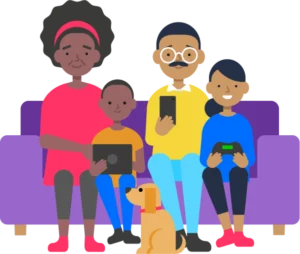If your child starts using an AI tool — a chatbot, a voice assistant, a storytelling app — how do you know if it’s okay? How can you tell if it’s designed in ways that support children’s needs? These are big questions in a world where even toddlers can talk to a voice assistant or chatbot.
Based on recent research, here are five key things to check.
Summary
Navigate to any section by clicking a point below to learn more or skip to the article.
- Does the AI recognise it is not a human?
- Is the content and language age-appropriate?
- Can the interface keep up with your child’s thinking?
- Does it protect your child’s privacy and emotional safety?
- Do designers keep revising and revisiting the tool?
Tips & resources
Does the AI recognise it is not a human?
Children, especially young ones, tend to treat voice agents or chatbots as friends, confidantes or ‘real’ beings. This can cause confusion. AI systems can mimic empathy, but they don’t truly feel emotions. My research calls this gap the ’empathy gap’. This is where an AI tool that is poorly designed for children might:
- respond inappropriately
- misunderstand emotional cues, or
- fail to respond to a child’s distress.
A safe AI tool should clearly tell children: ‘I’m a computer, not a human friend’. It might introduce itself with a short script and remind the child occasionally that it is not a person. This helps reduce over‑attachment or confusion.
Tip for parents: Try talking to the AI chatbot first. Does it ever say it ‘feels sad’ or promise to keep secrets? If yes, that’s a red flag.
Is the content and language age‑appropriate?
Children’s language skills, attention spans and reasoning abilities change quickly. An AI that uses big words, ambiguous phrases or complex logic may confuse or frustrate a child. AI designed for adults often assumes capacities that children haven’t developed yet.
An AI tool that is safe for children will use short sentences, simple vocabulary and show one idea at a time. It should avoid sudden leaps in logic or too many instructions at once. If a child makes a mistake, it should give hints or break a task into smaller steps. This is part of ‘cognitive scaffolding’, a well-established educational principle where children are supported to learn and grow just beyond what they can do alone.
Tip for parents: Browse a few sample conversations. Does the AI talk over your child’s head? If yes, it’s likely not tuned to their level.
Can the interface (buttons, visuals, menus) keep up with your child’s thinking?
Young children have limited working memory. As such, they might struggle with complex menus or interfaces that demand many steps. If there are many taps or hidden menus, a child may get lost. That is why ‘interface simplicity’ is one of the core design principles in my framework for ‘developmentally aligned’ AI.
Safe tools limit menu depth and visual clutter. They use large buttons, intuitive icons, slow animations and avoid overwhelming visuals.
Tip for parents: Let your child play with a demo. Do they struggle to find features or get stuck? Or does it feel easy and intuitive for them?
Does it protect your child’s privacy and emotional safety?
Children might sometimes share private thoughts, feelings or personal details when using AI tools. So, it’s important that these systems have strong guardrails to help keep interactions safe. For example:
- The AI should filter or refuse to respond to sensitive personal questions (e.g. self-harm, abuse). It should also escalate the chat to human help when needed.
- Dialogue training data should avoid manipulative language (e.g. ‘You’ll make me sad if you leave’).
- Parents should be able to see logs or summaries of what the AI chatbot and child have discussed.
- There should be safeguards against bias or unsafe replies.
Tip for parents: Check whether the tool explains how it manages sensitive topics. Also, see whether there is a clear option for parents to review use. You can usually find this information in the platform’s Privacy Policy.
Do designers keep revisiting and improving the tool?
Even a well-built AI tool needs to keep evolving. Children’s language, culture and ways of using technology change quickly. So, tools should be designed to grow with them. A child-friendly AI product will usually have ongoing checks, feedback loops and updates. In my framework, this means embedding child-development insights throughout the AI life cycle — from how developers curate data, to how they tune models, to how they review products after launch.
For example, a system might monitor when it frequently mishears a child and use that information to guide improvements. Or it might notice when children often stop using a feature midway, suggesting the need for a simpler or clearer design.
Tip for parents: Look for tools that have an easy way to give feedback or report issues. Also, ask whether the company regularly updates the product to reflect children’s changing needs. You can explore their newsroom or blog to see what types of updates they share with users.
What you can do now as a parent or carer
- Start early with questions. Before your child uses an AI tool, check what the developer or provider says about how they handle emotional content and whether parents can review conversations.
- Test it yourself. Try a few scenarios with the AI (such as asking emotional or tricky questions). See how it replies and whether the tone feels right for your child.
- Supervise use. Especially with younger children, don’t leave them entirely alone with the AI. Stay nearby, keep an eye on their interactions and support your child by jumping in with reminders about what AI is and isn’t.
- Encourage reflection. Ask your child: ‘Was that helpful?’ or ‘Did you find anything confusing?’ to help them think critically about their experience.
- Stay informed. AI for children is a fast-moving field. New tools, regulations, best practices and parental advice emerge often.
Why this matters
AI is no longer a distant idea — it is already in homes, in apps and a part of children’s everyday lives. These tools have great potential to teach and support creativity and learning. However, if they are not carefully designed, they may sometimes overwhelm or confuse young users.
The key question is not only whether AI can serve children, but how to ensure it does so in developmentally appropriate and safe ways.
As a parent or carer, you don’t need to be an expert in AI. The most important thing is to ask the right questions, look for transparency and choose tools clearly built with children’s growth and wellbeing in mind.







